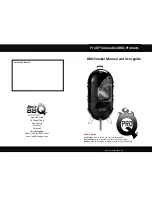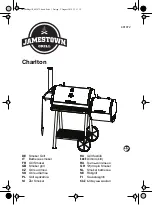
4
FOR YOUR SAFETY
WARNING: DO NOT touch any part of the Pellet Grill while the smoker is HOT.
Doing so could result in serious bodily injury.
FUEL—WOOD PELLETS
Only use
all natural wood pellets, designed for burning in pellet grills. Any other type of fuel burned in this
appliance will void the warranty and safety warning.
DO NOT
use fuel labeled as having additives.
Check with your local dealer on the quality of pellets in your area, and for information on what can be expected
from various brands.
NOTE:
As there is no control over the quality of pellets used with the appliance, Backyard Pro assumes no
liability caused by the quality of fuel.
DO NOT use gasoline, lighter-fluid or kerosene for lighting or refreshing a fire in your grill.
IF AN UNCONTROLLED FIRE DOES OCCUR: CALL THE FIRE DEPARTMENT.
DO NOT try to move appliance. DO NOT try to smother the fire. DO NOT put water on the fire.
To prevent fingers, clothing or other objects from coming in contact with the auger, your appliance has
been equipped with a metal screen, mounted inside the hopper. This screen MUST NOT be removed unless
directed by authorized sirvice personnel.
CARBON MONOXIDE: "The Silent Killer"
Follow these guidelines to prevent this colorless, odorless gas from poisoning you, your family or others.
1. Know the symptoms of carbon monoxide poisoning: headache, dizziness, weakness, nausea, vomiting,
sleepiness, and confusion. Carbon monoxide reduces the blood’s ability to carry oxygen. Low blood oxygen
levels can result in loss of consciousness and death.
2�
See a doctor if you or others develop cold or flu-like symptoms while cooking or in the vicinity of this
appliance. Carbon monoxide poisoning, which can easily be mistaken for a cold or flu, is often detected too
late�
3�
Alcohol consumption and drug use increase the effects of carbon monoxide poisoning. "Carbon Monoxide
is especially toxic to mother and child during pregnancy, infants, the elderly, smokers, and people with
blood or circulatory system problems, such as anemia, or heart disease.
4�
Creosote – Formation and need for removal. When wood pellets are burned slowly, they produce tar
and other organic vapors that combine with expelled moisture to form creosote. The creosote vapors
condense in a relatively cool oven flue and exhaust hood of a slow burning fire. As a result, creosote residue
accumulates on the flue lining and exhaust hood. When ignited, this creosote makes an extremely hot fire.
5�
The grease duct should be inspected at least twice a year to determine when grease and/or creosote
buildup has occurred.
6�
When grease or creosote has accumulated, it should be removed to reduce risk of fire.
7�
Disposal of ashes – Ashes should be placed in a metal container with a tight-fitting lid. The closed container
of ashes should be placed on a non-combustible floor or on the ground, well away from all combustible
materials, pending final disposal. When the ashes are disposed by burial in soil or otherwise locally
dispersed, they should be retained in the closed container until all cinders have thoroughly cooled.
8. Use pellet wood with no more than 8,700 BTU/lb and 2% ash content.
9�
Do not use accessories not specified for use with this appliance.
Summary of Contents for 554PL2026
Page 28: ...28...





































